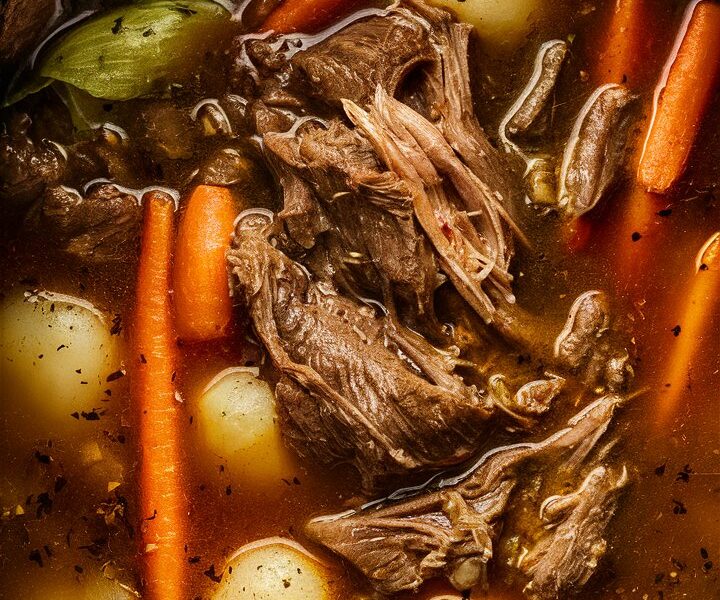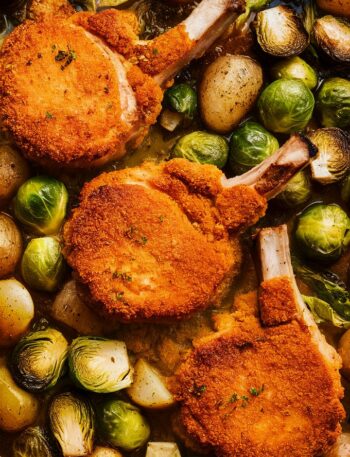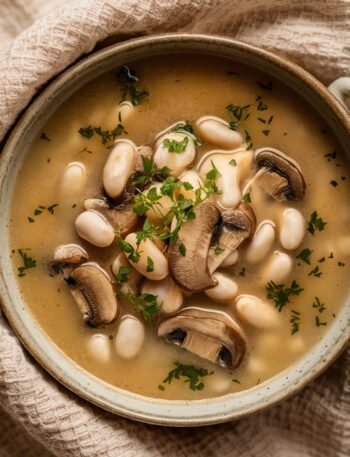Few recipes capture the warmth of home quite like a slow-cooked beef roast. For many families, this dish is a symbol of togetherness: a hearty meal shared after a long day, a comforting centerpiece for Sunday dinners, and a reliable favorite when guests arrive.
Among the many cuts of beef available, the rump roast stands out when prepared in a slow cooker. While it begins as a relatively tough cut of meat, hours of gentle simmering in a flavorful broth transform it into a tender, juicy masterpiece that slices easily and practically melts in your mouth. Combined with baby potatoes, carrots, and fresh herbs, this dish is nourishing, satisfying, and timeless.
In this article, you’ll find not only a step-by-step guide to making the perfect slow cooker rump roast with vegetables but also the science of why it works, cultural history, variations inspired by global cuisines, nutritional benefits, expert serving suggestions, storage tips, and solutions to common mistakes. Whether you’re a beginner or a seasoned cook, this guide will give you all the tools to prepare a roast that your family will remember long after the plates are cleared.
What Makes Slow Cooker Rump Roast Special?
The rump roast is cut from the hindquarter of the cow. Because this area is well-exercised, the meat is leaner and contains more connective tissue. At first glance, it might not seem as desirable as tenderloin or ribeye. However, slow cooking turns this cut into something extraordinary:
- Deep Flavor: The longer cooking process allows the natural beef flavor to intensify.
- Tender Texture: Collagen in the connective tissue breaks down into gelatin, giving the roast a succulent texture.
- Affordability: It’s cost-effective compared to premium cuts.
- Versatility: Works beautifully with herbs, spices, vegetables, and sauces.
- Convenience: Place it in the slow cooker, set the timer, and let the appliance do the work.
The slow cooker is a busy cook’s best friend. You can start your roast in the morning and return in the evening to a house filled with comforting aromas and a dinner that tastes as though you spent all day tending to it.
Ingredients Breakdown and Their Role
Every ingredient in this dish plays a role in balancing flavors, adding texture, and building the overall profile of the meal.
Rump Roast
A lean, flavorful cut that benefits from long, moist cooking. Choose a 3–4 pound roast with some marbling for best results. Trim excessive fat, but leave a thin layer to baste the meat as it cooks.
Baby Potatoes
Waxy potatoes like yellow or red baby potatoes hold their shape during hours of cooking. They soak up the broth while remaining tender but not mushy.
Carrots
Their natural sweetness contrasts with the savory broth and adds color to the dish.
Onions
Onions provide a foundational flavor. As they caramelize in the slow cooker, they enrich the broth with sweetness and complexity.
Beef Broth
The cooking liquid that keeps the roast moist and flavorful. Use low-sodium broth so you can control seasoning.
Fresh Herbs
- Rosemary: Provides a piney, woodsy aroma.
- Thyme: Adds subtle earthiness.
Using fresh herbs elevates the dish, though dried herbs can work in smaller amounts.
Seasonings
- Salt: Enhances natural flavors.
- Black Pepper: Balances richness with a mild spice.
Optional Flavor Boosters
- Garlic cloves: For added depth.
- Red wine: Adds complexity and French flair.
- Worcestershire sauce: Intensifies umami.
Step-by-Step Cooking Guide
Step 1: Preparing the Roast
Pat the roast dry with paper towels. Season generously with salt and pepper. Optionally, sear the roast in a hot skillet for 2–3 minutes per side until browned—this adds depth and locks in flavor.
Step 2: Layering Vegetables
Place quartered onions, baby potatoes, and carrots at the bottom of the slow cooker. These act as a natural base for the roast while absorbing juices.
Step 3: Adding Herbs and Broth
Lay the seasoned roast on top of the vegetables. Add sprigs of rosemary and thyme. Pour in 3–4 cups of beef broth until it nearly covers the vegetables but leaves the roast exposed.
Step 4: Cooking
- On LOW: 7–8 hours for maximum tenderness.
- On HIGH: 4–5 hours if you’re short on time.
Keep the lid closed—each time you lift it, heat escapes and prolongs cooking.
Step 5: Resting and Serving
When the roast is fork-tender, remove it from the slow cooker and let it rest for 5–10 minutes before slicing against the grain. Serve with vegetables and ladle the broth on top.
The Science Behind a Perfect Roast
Cooking tough cuts like rump roast is about patience. Inside the meat, collagen is a protein that gives muscle its structure. When heated slowly with moisture, collagen turns into gelatin, which is what makes meat tender and juicy.
Slow cooking also allows vegetables to break down gently, releasing natural sugars that sweeten the broth. Herbs infuse gradually, so the longer they cook, the more pronounced their flavors become.
Flavor Variations and Global Twists
One of the joys of a simple recipe like this is its adaptability. Here are a few creative takes:
- French Style: Add 1 cup of red wine, mushrooms, and pearl onions.
- Italian Style: Replace rosemary and thyme with oregano and basil; add tomatoes.
- Mexican Style: Season with cumin, chili powder, and coriander; add bell peppers.
- Asian Fusion: Add soy sauce, ginger, and star anise for aromatic depth.
- Garlic Lovers: Toss in 6–8 whole garlic cloves for bold flavor.
Serving Suggestions
Pair your roast with sides that complement its richness:
- Mashed potatoes with gravy.
- Steamed green beans or asparagus.
- Crusty bread to soak up juices.
- Fresh salad with vinaigrette for brightness.
- Rice or noodles for a filling base.
For drinks, a medium-bodied red wine like Merlot or Cabernet Sauvignon pairs beautifully.
Storage, Leftovers, and Meal Prep
- Refrigerate: Store in an airtight container for up to 4 days.
- Freeze: Meat and vegetables freeze well for up to 3 months.
- Reheat: Warm gently with extra broth on the stove or in the microwave.
Creative leftover ideas:
- Shred beef for sandwiches.
- Toss with pasta for a quick meal.
- Add to soups or stews.
Nutritional Information (Approximate, per serving)
- Calories: 420
- Protein: 36g
- Carbohydrates: 20g
- Fat: 18g
- Fiber: 4g
- Sodium: 780mg
Common Mistakes to Avoid
- Overcooking vegetables: Cut them larger or add halfway through.
- Not seasoning enough: Always taste and adjust.
- Using too much liquid: The slow cooker traps steam; a few cups of broth is enough.
- Lifting the lid: Each peek adds 20–30 minutes to cooking time.
FAQs
Q: Do I need to brown the roast first?
It’s optional but enhances flavor.
Q: Can I cook overnight?
Yes—set on LOW for 8 hours, then switch to WARM.
Q: Can I make this gluten-free?
Yes, just use gluten-free broth and thickeners.
Q: How do I make gravy?
Strain broth, whisk in a cornstarch slurry, and simmer until thick.
Q: Can I add more vegetables?
Absolutely—parsnips, celery, or mushrooms work well.
History and Cultural Background of Pot Roast
Pot roast traces its roots to European cooking traditions, especially in France, where braising tougher cuts in wine and broth was common. Immigrants brought the technique to America, where it became a staple of Sunday dinners. Over time, regional variations developed—some families used beer, others added root vegetables, and many incorporated cultural spices.
The slow cooker, invented in the 1940s, revolutionized the dish by making it even more convenient. Today, rump roast remains a budget-friendly yet celebratory choice for family gatherings.
Final Thoughts
The slow cooker rump roast with vegetables is more than a recipe—it’s a reminder that great food doesn’t have to be complicated. With a few simple ingredients, patience, and the right technique, you can create a meal that feels special but is easy enough for any day of the week.
Whether you follow the classic version or experiment with international flavors, this dish guarantees satisfaction. It’s hearty, nourishing, and endlessly versatile—the very definition of comfort food.





